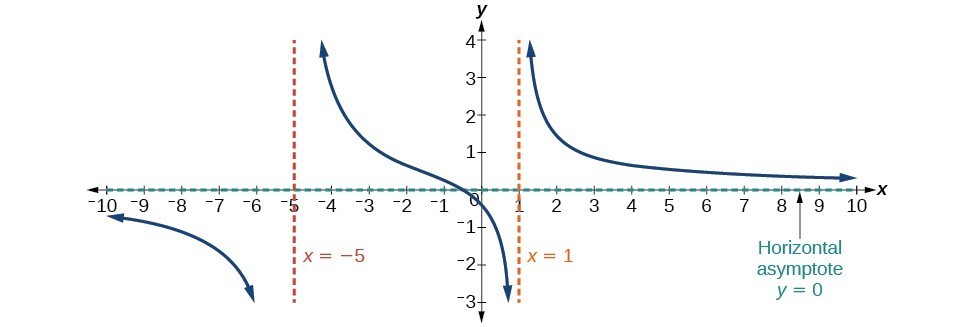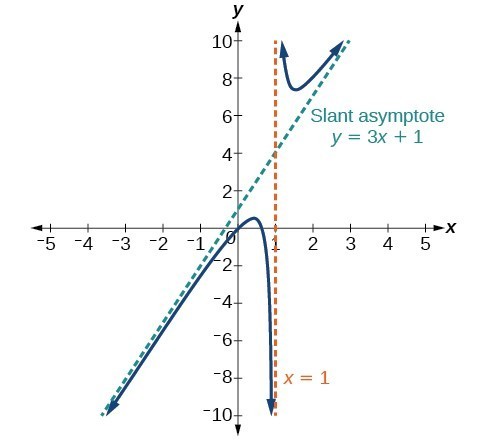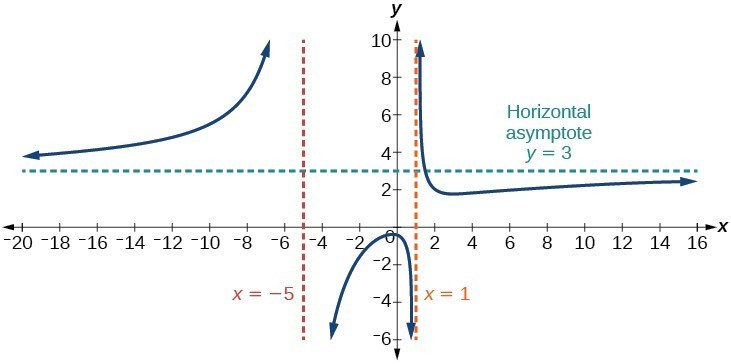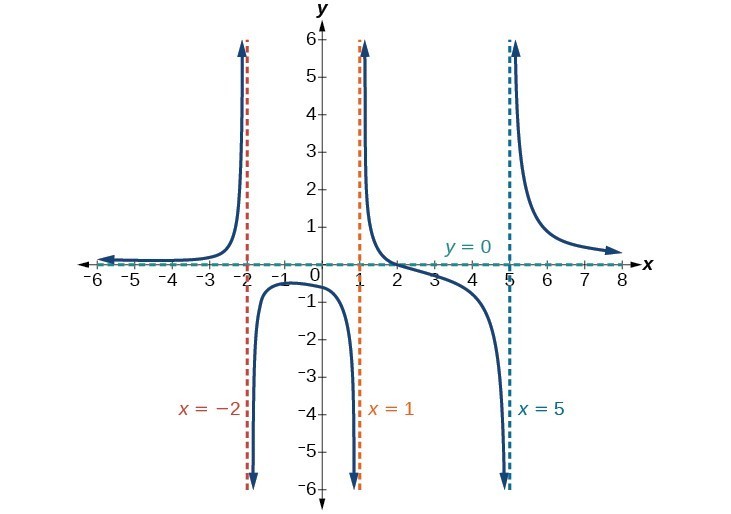Identify horizontal asymptotes
While vertical asymptotes describe the behavior of a graph as the output gets very large or very small, horizontal asymptotes help describe the behavior of a graph as the input gets very large or very small. Recall that a polynomial’s end behavior will mirror that of the leading term. Likewise, a rational function’s end behavior will mirror that of the ratio of the leading terms of the numerator and denominator functions. There are three distinct outcomes when checking for horizontal asymptotes: Case 1: If the degree of the denominator > degree of the numerator, there is a horizontal asymptote at y = 0.
Figure 12. Horizontal Asymptote y = 0 when [latex]f\left(x\right)=\frac{p\left(x\right)}{q\left(x\right)}, q\left(x\right)\ne{0}\text{ where degree of }p<\text{degree of }q[/latex].
Case 2: If the degree of the denominator < degree of the numerator by one, we get a slant asymptote.
Figure 13. Slant Asymptote when [latex]f\left(x\right)=\frac{p\left(x\right)}{q\left(x\right)},q\left(x\right)\ne 0[/latex] where degree of [latex]p>\text{degree of }q\text{ by }1[/latex].
Case 3: If the degree of the denominator = degree of the numerator, there is a horizontal asymptote at [latex]y=\frac{{a}_{n}}{{b}_{n}}[/latex], where [latex]{a}_{n}[/latex] and [latex]{b}_{n}[/latex] are the leading coefficients of [latex]p\left(x\right)[/latex] and [latex]q\left(x\right)[/latex] for [latex]f\left(x\right)=\frac{p\left(x\right)}{q\left(x\right)},q\left(x\right)\ne 0[/latex].
Figure 14. Horizontal Asymptote when [latex]f\left(x\right)=\frac{p\left(x\right)}{q\left(x\right)},q\left(x\right)\ne 0\text{ where degree of }p=\text{degree of }q[/latex].
Notice that, while the graph of a rational function will never cross a vertical asymptote, the graph may or may not cross a horizontal or slant asymptote. Also, although the graph of a rational function may have many vertical asymptotes, the graph will have at most one horizontal (or slant) asymptote. It should be noted that, if the degree of the numerator is larger than the degree of the denominator by more than one, the end behavior of the graph will mimic the behavior of the reduced end behavior \fraction. For instance, if we had the functionA General Note: Horizontal Asymptotes of Rational Functions
The horizontal asymptote of a rational function can be determined by looking at the degrees of the numerator and denominator.- Degree of numerator is less than degree of denominator: horizontal asymptote at y = 0.
- Degree of numerator is greater than degree of denominator by one: no horizontal asymptote; slant asymptote.
- Degree of numerator is equal to degree of denominator: horizontal asymptote at ratio of leading coefficients.
Example 7: Identifying Horizontal and Slant Asymptotes
For the functions below, identify the horizontal or slant asymptote.- [latex]g\left(x\right)=\frac{6{x}^{3}-10x}{2{x}^{3}+5{x}^{2}}[/latex]
- [latex]h\left(x\right)=\frac{{x}^{2}-4x+1}{x+2}[/latex]
- [latex]k\left(x\right)=\frac{{x}^{2}+4x}{{x}^{3}-8}[/latex]
Solution
For these solutions, we will use [latex]f\left(x\right)=\frac{p\left(x\right)}{q\left(x\right)}, q\left(x\right)\ne 0[/latex].- [latex]g\left(x\right)=\frac{6{x}^{3}-10x}{2{x}^{3}+5{x}^{2}}[/latex]: The degree of [latex]p=\text{degree of } q=3[/latex], so we can find the horizontal asymptote by taking the ratio of the leading terms. There is a horizontal asymptote at [latex]y=\frac{6}{2}[/latex] or [latex]y=3[/latex].
- [latex]h\left(x\right)=\frac{{x}^{2}-4x+1}{x+2}[/latex]: The degree of [latex]p=2[/latex] and degree of [latex]q=1[/latex]. Since [latex]p>q[/latex] by 1, there is a slant asymptote found at [latex]\frac{{x}^{2}-4x+1}{x+2}[/latex].
The quotient is [latex]x - 6[/latex] and the remainder is 13. There is a slant asymptote at [latex]y=x - 6[/latex].
- [latex]k\left(x\right)=\frac{{x}^{2}+4x}{{x}^{3}-8}[/latex]: The degree of [latex]p=2\text{ }<[/latex] degree of [latex]q=3[/latex], so there is a horizontal asymptote y = 0.
Example 8: Identifying Horizontal Asymptotes
In the sugar concentration problem earlier, we created the equation [latex]C\left(t\right)=\frac{5+t}{100+10t}[/latex]. Find the horizontal asymptote and interpret it in context of the problem.Solution
Both the numerator and denominator are linear (degree 1). Because the degrees are equal, there will be a horizontal asymptote at the ratio of the leading coefficients. In the numerator, the leading term is t, with coefficient 1. In the denominator, the leading term is 10t, with coefficient 10. The horizontal asymptote will be at the ratio of these values:Example 9: Identifying Horizontal and Vertical Asymptotes
Find the horizontal and vertical asymptotes of the functionSolution
First, note that this function has no common factors, so there are no potential removable discontinuities. The function will have vertical asymptotes when the denominator is zero, causing the function to be undefined. The denominator will be zero at [latex]x=1,-2,\text{and }5[/latex], indicating vertical asymptotes at these values. The numerator has degree 2, while the denominator has degree 3. Since the degree of the denominator is greater than the degree of the numerator, the denominator will grow faster than the numerator, causing the outputs to tend towards zero as the inputs get large, and so as [latex]x\to \pm \infty , f\left(x\right)\to 0[/latex]. This function will have a horizontal asymptote at [latex]y=0[/latex]. Figure 15
Figure 15Try It 6
Find the vertical and horizontal asymptotes of the function:[latex]f\left(x\right)=\frac{\left(2x - 1\right)\left(2x+1\right)}{\left(x - 2\right)\left(x+3\right)}[/latex]
SolutionA General Note: Intercepts of Rational Functions
A rational function will have a y-intercept when the input is zero, if the function is defined at zero. A rational function will not have a y-intercept if the function is not defined at zero. Likewise, a rational function will have x-intercepts at the inputs that cause the output to be zero. Since a \fraction is only equal to zero when the numerator is zero, x-intercepts can only occur when the numerator of the rational function is equal to zero.Example 10: Finding the Intercepts of a Rational Function
Find the intercepts of [latex]f\left(x\right)=\frac{\left(x - 2\right)\left(x+3\right)}{\left(x - 1\right)\left(x+2\right)\left(x - 5\right)}[/latex].Solution
We can find the y-intercept by evaluating the function at zero[latex]0=\frac{(x-2)(x+3)}{(x-1)(x+2)(x-5)}[/latex] This is zero when the numerator is zero.
[latex]0=(x-2)(x+3)[/latex]
[latex]x=2, -3[/latex]
The y-intercept is [latex]\left(0,-0.6\right)[/latex], the x-intercepts are [latex]\left(2,0\right)[/latex] and [latex]\left(-3,0\right)[/latex]. Figure 16
Figure 16Try It 7
Given the reciprocal squared function that is shifted \right 3 units and down 4 units, write this as a rational function. Then, find the x- and y-intercepts and the horizontal and vertical asymptotes. SolutionLicenses & Attributions
CC licensed content, Shared previously
- Precalculus. Provided by: OpenStax Authored by: Jay Abramson, et al.. Located at: https://openstax.org/books/precalculus/pages/1-introduction-to-functions. License: CC BY: Attribution. License terms: Download For Free at : http://cnx.org/contents/[email protected]..

